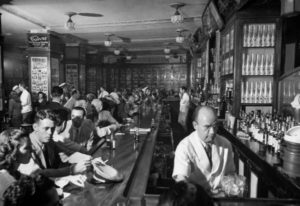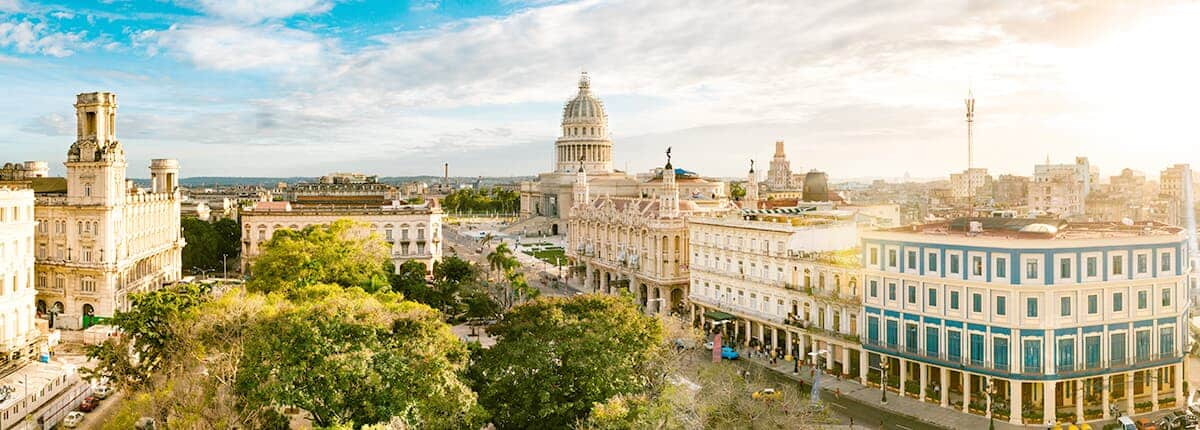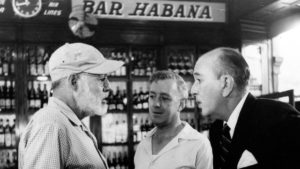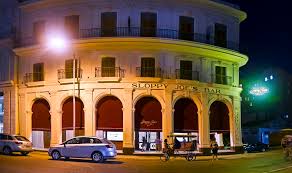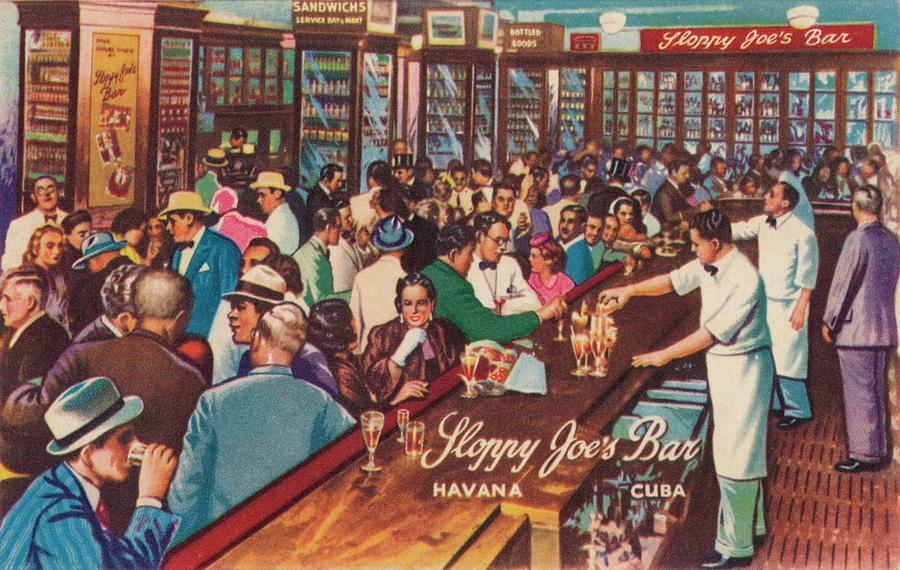 THE SLOPPY JOE’S, UN SOBREVIVIENTE DE LA HAVANA VIEJA.
THE SLOPPY JOE’S, UN SOBREVIVIENTE DE LA HAVANA VIEJA.
En las primeras décadas del siglo XX entre los famosos bares habaneros se destacaba como uno de los de mayor venta el “Sloppy Joe’s”, ubicado en la céntrica esquina de las calles Zulueta y Ánimas, en La Habana Vieja.
El fundador del famoso bar fue el español José Abeal, quien llegó a Cuba en 1904, después de trabajar en la isla un tiempo salió a buscar suerte en el extranjero y regresó en 1918. Pasado algunos meses compró un viejo bodegón ubicado en el edificio de Zulueta esquina a Ánimas y fue la persona que transformó este local decadente en uno de los bares más famosos de La Habana; llegó a ser considerado como uno de los tres mejores de Cuba, compartiendo puesto con El Floridita y La Bodeguita del Medio.
A fin de explotar el nuevo establecimiento, Abeal se asoció con otras personas, coexistiendo en el inmueble de la calle Zulueta en 1924 el bar, una cantina y una venta de tabacos.
El triunfo del establecimiento se vio favorecido por su propietario, quien en momentos de crisis decidió rebajar los precios de las bebidas a la mitad, lo que evidentemente atrajo numerosos consumidores.
Un cliente habitual del Bar Sloppy Joe´s era el famoso escritor norteamericano Ernest Hemingway, quien, incluso, lo frecuentaba con su amigo Joe Russell, propietario de otro Sloppy Joe’s Bar, pero en Cayo Hueso, se comenta que el nombre de aquel fue sugerido por el propio Hemingway en honor al bar de La Habana. El establecimiento era frecuentado por muchas celebridades de Hollywood y también por importantes figuras internacionales. Otros clientes ilustres fueron los músicos cubanos Ignacio Jacinto Villa “Bola de Nieve”, y José Antonio Méndez, “The King”.
En la carta original el bar contaba con 33 cocteles confeccionados por su barman cubano Fabio Delgado, quien creó uno especialmente dedicado al astro del cine estadounidense Errol Flynn y entre los platos fuertes de su oferta gastronómica se destacaba la “ropa vieja” y el fabuloso sándwich cubano.
Entre los años 40 y 50 del siglo pasado fue visitado por otros famosos, como los actores Spencer Tracy, Clark Gable y Jhon Wayne, el boxeador Sugar Ray Robinson y Joe Lois, entre otras celebridades y músicos de la época.
Cerrado durante casi 50 años reabrió sus puertas en 2013, tras una rigurosa restauración capital acometida por la Oficina del Historiador de la Ciudad de La Habana, Eusebio Leal. La reanimación se materializó gracias al ingenio de hábiles especialistas, materiales donados y valiéndose de fotografías obtenidas que le imprimen una imagen exacta de su aspecto original.
A la par reluce con su barra única de 18 metros de madera de caoba negra, considerada la más larga de toda Cuba e inmortalizada en 1959 en la película británica “Nuestro Hombre en La Habana”.
Adicionales atractivos como su mobiliario, diseño interior la coctelería y los alimentos ligeros que se expenden el “Sloppy” recrea el ambiente de su época signado como refugio de estrellas de cine, turistas y personalidades.
Al visitar el lugar es como volver a darle al reloj hacia atrás en el tiempo, porque se trata de una edificación construida en 1884, dentro del último periodo colonial cubano; ahora con una atmósfera de nostalgias, historias y alguna que otra leyenda, sobreviviente por casi 100 años, una espiritualidad detenida en el tiempo.
www.TheCubanhistory.com < SEARCH -EVERYTHING ABOUT CUBA.
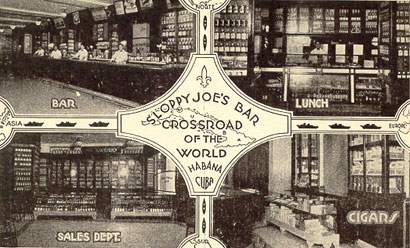 THE SLOPPY JOE’S, A HAVANA VIEJA SURVIVOR.
THE SLOPPY JOE’S, A HAVANA VIEJA SURVIVOR.
In the first decades of the twentieth century among the famous Havana bars stood out as one of the best selling the “Sloppy Joe’s”, located in the central corner of Zulueta and Ánimas streets, in Old Havana.
The founder of the famous bar was the Spaniard José Abeal, who arrived in Cuba in 1904, after working on the island for a while he went abroad to look for luck and returned in 1918. After a few months he bought an old still life located in the building of Zulueta corner to Ánimas and was the person who transformed this decadent place into one of the most famous bars in Havana; He came to be considered one of the three best in Cuba, sharing position with El Floridita and La Bodeguita del Medio.
In order to exploit the new establishment, Abeal was associated with other people, coexisting in the building of Zulueta Street in 1924 the bar, a canteen and a sale of cigars.
The triumph of the establishment was favored by its owner, who in times of crisis decided to reduce the prices of drinks by half, which evidently attracted numerous consumers.
A regular customer of Bar Sloppy Joe’s was the famous American writer Ernest Hemingway, who even frequented him with his friend Joe Russell, owner of another Sloppy Joe’s Bar, but in Key West, it is said that his name was suggested by Hemingway himself in honor of the Havana bar. The establishment was frequented by many Hollywood celebrities and also by important international figures. Other illustrious clients were the Cuban musicians Ignacio Jacinto Villa “Bola de Nieve”, and José Antonio Méndez, “The King”.
In the original menu the bar had 33 cocktails made by his Cuban bartender Fabio Delgado, who created one specially dedicated to the star of the American cinema Errol Flynn and among the highlights of its gastronomic offer stood out the “old clothes” and the fabulous sandwich Cuban.
Between the 40s and 50s of the last century, he was visited by other celebrities, such as the actors Spencer Tracy, Clark Gable and John Wayne, the boxer Sugar Ray Robinson and Joe Lois, among other celebrities and musicians of the time.
Closed for almost 50 years, it reopened its doors in 2013, after a rigorous capital restoration undertaken by the Office of the Historian of the City of Havana, Eusebio Leal. The resuscitation materialized thanks to the ingenuity of skilled specialists, donated materials and using photographs obtained that print an exact image of its original appearance.
At the same time, it shines with its unique bar of 18 meters of black mahogany wood, considered the longest of all Cuba and immortalized in 1959 in the British film “Our Man in Havana”.
Additional attractive as its furniture, interior design, cocktails and light foods that are sold in the “Sloppy” recreates the atmosphere of his time as a refuge for film stars, tourists and personalities.
When visiting the place it is like returning to the clock backward in time, because it is a building built in 1884, within the last Cuban colonial period; now with an atmosphere of nostalgia, stories and the odd legend, surviving for almost 100 years, a spirituality stopped in time.
Agencies/ RHC/ Guadalupe Yaujar/ Extractos/ Pedro M.Otero/ Internet Photos/ Arnoldo Varona/ www.TheCubanHistory.com
THE CUBAN HISTORY, HOLLYWOOD.
www.TheCubanHistory.com < SEARCH - EVERYTHING ABOUT CUBA.



